Mike Keenan – New York Rangers’ angel or demon?

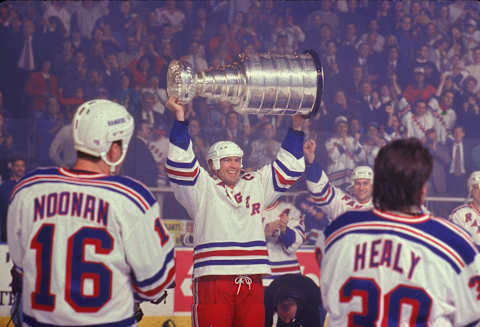
As New York Rangers fans get ready to celebrate the twenty-sixth anniversary of that glorious Stanley Cup victory, led by Mike Keenan, let’s take a deeper look at what that triumph might have cost.
We are little over a month away from an important New York Rangers anniversary, twenty-six years since the Curse was broken, the Cup lifted by the Messiah.
Talk will once again turn to that remarkable time, reminiscing about sweeping the Islanders out of the postseason, finally getting past Washington, Captain Courageous’ guarantee (and hat trick) against the Devils , that last 1.6 seconds in Game 7 of the Finals, the SURETY that the season could still somehow fall apart, picturing Vancouver scoring the tying goal and then the OT winner that would destroy us, mock us for daring to dream.
And some might reflect on how it’s been a quarter of a century since Mike Keenan came, took us to the Promised Land, then abruptly left, tearing a hole in the team that took over a decade to heal.
For Gen Z, 1994 is a history lesson, grainy black and white film footage like the Zapruder Film. And the Greatest Generation either can’t remember 1994 or would tell you Igor Shesterkin is no Dave Kerr and how Shelly Winters was hotter than Marilyn Monroe back before Germany invaded Poland.
But for Baby Boomers, Gen X’ers, and a sprinkling of Millennials, there are certain names sure to bring a smile to their lips. Not just Mark Messier, Mike Richter, and Brian Leetch, but also the other players, the ones we don’t think of as often. Sergei Zubov, Alexei Kovalev, Jeff Beukeboom, even Esa Tikkanen, and of course, Stephane Matteau! Matteau! Matteau!
The 1993-94 Rangers weren’t exactly a fluke, lightning in a bottle. New York was a talented team in the early 90’s.
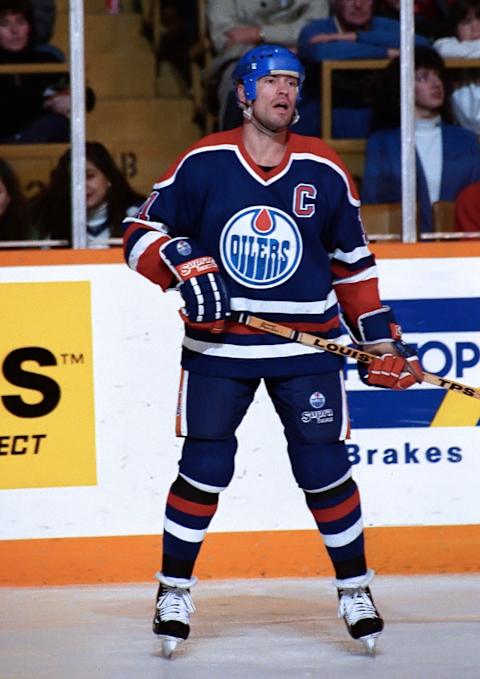
What came before
With Brian Leetch, Mike Gartner, Tony Amonte, Darren Turcotte, and the addition of Adam Graves, New York’s roster was fairly loaded before they traded for Mark Messier in 1991, with not just one but two solid netminders, John Vanbiesbrouck and Mike Richter.

The Rangers consistently made the playoffs but could never seal the deal, getting knocked out twice each by the Capitals,1990 and 1991, and Penguins, 1989 and again in 1992 after winning the Presidents Trophy. They lacked something that was necessary to make it to the pinnacle.
But as disappointing as those failures were, the next year would be even worse.
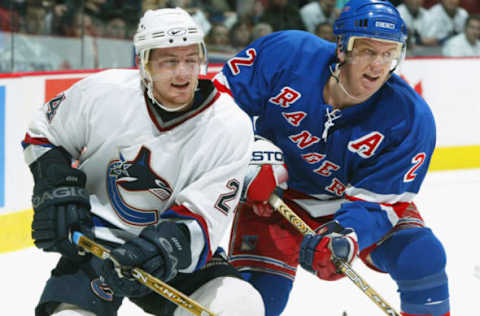
Setting a record, but not a good one
The 1992-93 season was simply a disaster.
It might have just been due to the bad luck suffered by Brian Leetch, limited to 36 games that season, because the team still had a winning record when he played. But a missed check against the Blues took Leetch into the boards and the resulting pinched nerve meant 34 games missed.
But 10 days after he returned, there was another on-ice incident that didn’t take place on a hockey rink. Debate still rages whether ice on the sidewalk was more to blame or possibly the ice in his drinks that night. Either way, he broke his ankle and the Rangers finished the season 2-11-0 without him, losing their last seven games.
Leetch’s presence was missed, but there was more to the team’s discontent. G.M. Neil Smith tried very hard to acquire the rights to newly drafted Eric Lindros and various reports had the team offering Quebec Tony Amonte, Alexei Kovalev, Doug Weight (or Sergei Nemchinov and James Patrick), their choice of John Vanbiesbrouck or Mike Richter, as well as first-round picks in 1993, 1994, and 1996.
AND $12 million.
Twelve million in 1990’s dollars, not post-2000, Kylie Jenner-is-a-billionaire dollars.
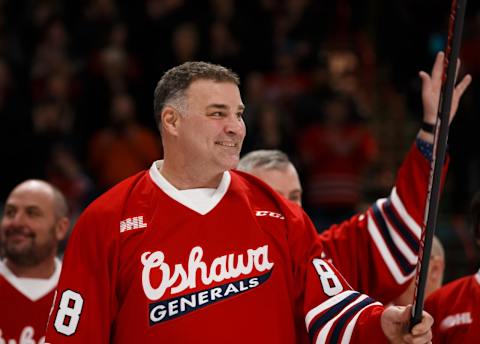
Naturally, the Nordiques jumped at the deal, but there was a problem. They had already agreed to trade Lindros to Philadelphia. The league had to come in and they ruled that the Flyers transaction was completed first.
So, not only didn’t the Rangers get Kid Concussion, not only were five or more Rangers players upset they had been dangled as trade bait, but their captain was less than enthused about Head Coach Roger Neilson. Right or wrong, it sure looked as if the team followed Messier’s example and tuned out, tanking the second half of the season. The situation didn’t improve even after Neilson was fired and replaced with interim coach Ron Smith.
They finished last in the final year of the old Patrick Division, with a record of 34-39-11. The Blueshirts became the first team in NHL history to win the Presidents Trophy one year and not make the playoffs the following season. Even now, 26 years later, it’s only happened two other times, with Buffalo in 2007-08 and Boston in 2014-15.
“Nine-teen for-ty” rang out more and more often, both at opposing venues and at home. Something needed to change.
Enter: Iron Mike.
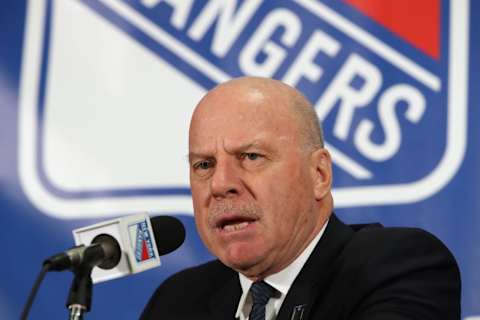
A phoenix rises from the ashes
In April of 1993, the New York Rangers tabbed Mike Keenan to be their new head coach.
On first glance, Keenan had an impressive resume. In eight years of coaching, his teams had never failed to make the playoffs, and got to the Finals three times. But a closer look showed his squads had lost the Stanley Cup Finals three times, he’d been fired by Philadelphia one year after almost winning the Cup, and forced off the bench in Chicago and into focusing on being a G.M. right after taking them to the Finals. Red flags, all.
Still, Neil Smith probably would have been happy if Keenan could do a similar job in Madison Square Garden, getting them that close to a championship. The team needed someone to lead them, to make them reach higher.
They got that in spades.
Stumbling out of the blocks
The Rangers didn’t quite start the 1993-94 season on fire. After the relatively easygoing Roger Neilson and Ron Smith, Keenan showed them his brand of tough love. Emphasis on the tough, not so much the love.
How bad could he be? Later on, when he was coaching St. Louis, Dale Hawerchuk‘s dying grandmother came all the way from Ontario to Buffalo to see him on the ice one more time. Keenan didn’t allow Hawerchuk to play that game, benching him. When Hull loudly voiced his disapproval, the coach took away Hull’s captaincy.
With the Rangers, Keenan sat stars like Brian Leetch and pulled the goalie with alarming frequency, at times either embarrassing or challenging Mike Richter, depending on your viewpoint.
And the team may not have liked it, but the results were promising. After trading for Steve Larmer and Nick Kypreos (jettisoning James Patrick and Darren Turcotte), they were in first place in the division as New Year’s drew nearer, and they had their sights set on another Presidents Trophy.
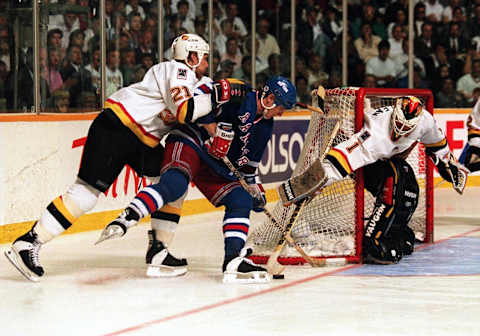
But in March, after losing to Detroit at the Garden, then to Pittsburgh on the road, the Blackhawks blew their doors off in a 7-3 home loss.An important road trip was coming up and one thing seemed clear to Rangers management. The team was good, but not good enough to win a Cup. And Mike Keenan didn’t think they were nearly tough enough. All season, he’d pressured Smith to trade for the pieces he wanted and to get rid of those that didn’t play the way he wanted them to play.
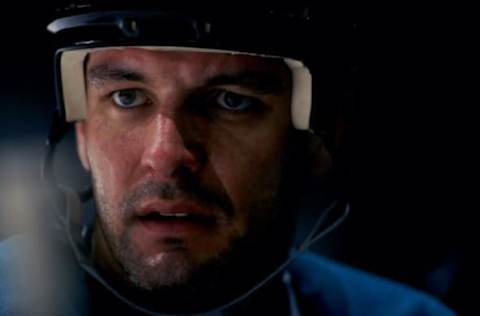
High on his wish list was Stephane Matteau, a big (6’4″ 220), tough forward who (like Larmer) Keenan knew from his days in Chicago and he strongly encouraged Neil Smith to get him.
That deal would have a high cost. The Blackhawks wanted Tony Amonte in exchange. Amonte scored 68 goals in his first two seasons, but that production fell by half under Keenan. Smith didn’t want to trade him, but after Chicago threw in Brian Noonan (and presumably a boatload of pressure from Keenan) the deal got done.
But New York was still in need of another center. Matteau and Noonan were Keenan’s guys, but Neil Smith wanted yet another veteran with Cups on his resume.
More short-term gains, long-term losses
The Rangers were operating that season without a true center. Esa Tikkanen (acquired for the previously dangled Doug Weight) was playing that position, but he was normally a winger. For months, Neil Smith had been badgering Oilers’ General Manager Glen Sather for veteran Craig MacTavish, wanting someone who could win faceoffs and kill penalties.
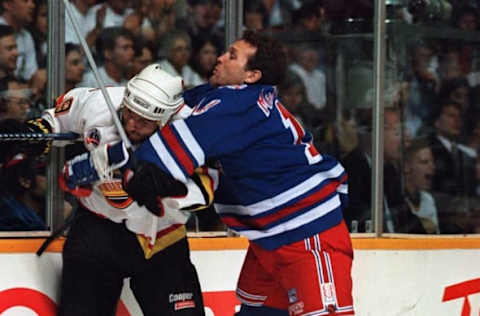
Even though Edmonton’s glory days were in the rear-view mirror, Sather was hesitant to trade away one of the last links to their amazing past. In the end, all it cost the Rangers was center Todd Marchant, a fast skater who had played exactly one game in the NHL to that point.
But the dealing wasn’t done yet.
Mike Gartner had piled up most of his over 400 goals playing for the Washington Capitals and Minnesota North Stars, but he had put in four solid years for the Rangers, including three straight seasons of 40-plus goals (49 in 1990-91), the biggest scoring threat to take up residence in the Garden since the bygone years of Vic Hadfield.
Still, he was another speedy player Keenan wanted to replace with a tougher specimen, somebody who showed a bit more when the post-season rolled around.
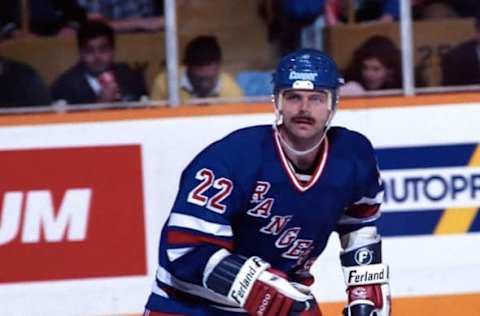
It was another case of Iron Mike bullying Smith into getting rid of a good player for someone who fit Keenan’s scheme a bit better. So Gartner was traded to Toronto for another star whose best days were behind him, Glenn Anderson. But Anderson had a fistful of rings and Keenan valued that veteran playoff experience.
So a team that was (arguably) the best in the NHL shredded their roster, making five trades with 12 games to go in the season. Even if the transactions were a net positive, would the new players have time to get to know their new team (and teammates) before the playoffs started?
The reconfigured Blueshirts played their first game in Calgary, where Glenn Anderson scored two goals, putting the Rangers ahead 3-2, but the Flames scored twice in nine minutes to take the lead.
Then, Stephane Matteau justified Keenan’s trading for him. With Richter out of goal, Matteau evened the score with 14 seconds left, leading to a tie on the road. He got another goal the next game in Edmonton, which was a pretty good introduction to Rangers fans.
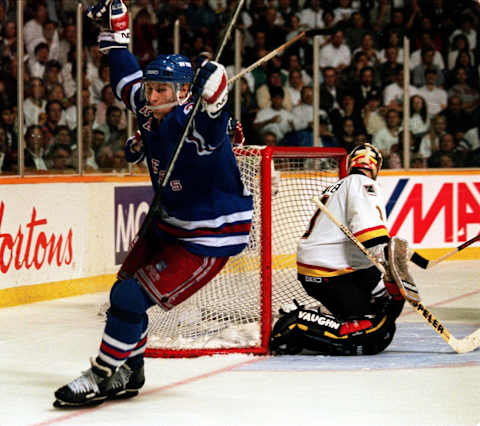
The road to victory
You probably don’t need me to tell you what happened after the regular season ended. And if you do, you’re better served by cueing up Road to Victory, on VHS if you want that old-timey feel and haven’t worn out the tape, the DVD replacement if you have.
The Blueshirts swept the Islanders right out of the arena, then finally got past the Capitals before the monumental clash with Martin Brodeur and the Devils, and the icing on the cake, 7 games of heaven and hell versus the Canucks.
We all know Matteau contributed in the postseason, with not one, but TWO double-overtime winning goals against the Devils, one of them in Game 7.
Three double-overtime contests in a seven game series. I’m having flashback sweats just thinking about that.
Anderson (2 game-winning goals in the Finals), MacTavish, and Noonan also contributed to the Rangers breaking the Curse and lifting the Cup.
That year, a very good Rangers team developed a serious case of ‘win now’ disease and an argument could be made that most (if not all) of the trades worked, as it led to a Championship. I personally think that the most important person leading to the 94 Cup was Iron Mike himself. More than Richter, more than Leetch, even more than Messier, though that’s not to say he could have won without them. Keenan pushed and prodded and poked and provoked. And he succeeded.
And then Iron Mike was gone after a single extraordinary season, claiming the Rangers breached his contract by being one day late on a bonus payment.
So, we won. But at what price? We have that moment, memories nobody can take away from us, but what could have been?
The team most likely would have won the Presidents Trophy that year even without any new additions. They had the highest regular season point total two years earlier. What if the 93-94 Rangers were like Michael Jordan’s Bulls, banging their head against the ceiling, unable to get past the Celtics, then the Pistons, until they made themselves even better, with 6 NBA titles and who knows how many more if Jordan hadn’t….ahem…retired to play minor league baseball?
What if the Rangers didn’t make some of the most one-sided trades in NHL history, maybe the most clear-cut example of a team mortgaging its future, to win a Stanley Cup?
Sent packing were:
Tony Amonte – Darren Turcotte – James Patrick – Mike Gartner – Doug Weight – Todd Marchant
Players acquired:
Stephane Matteau – Brian Noonan – Steve Larmer – Glenn Anderson- Esa Tikkanen – Nick Kypreos – Craig MacTavish
Stephane Matteau wound up playing 85 games for the Rangers. Basically, a season. Esa Tikkanen also gave the team one good season, with two encores years later. Glenn Anderson and Craig MacTavish were each in a grand total of 12 regular season games and 23 in the playoffs for New York. After winning the Cup, Steve Larmer had one mediocre season left in him.
And the players given up to get them?
Doug Weight would play in 1,200 games and notch over 1,000 points. Todd Marchant had suited up in exactly one game for the Rangers, but he wound up playing 1,194 more before calling it a career. After two promising seasons as a Blueshirt, Tony Amonte continued to rack up points, a total of 416 goals and 484 assists in 1,174 games. Mike Gartner only played four more seasons, but he could have put in three solid years at the Garden.
Those traded went on to play almost 4,500 NHL games after they left New York, scoring 988 goals and 2,662 assists, with ten all-star seasons. The players acquired gave the Rangers 597 regular season games, 110 goals, and 256 points.
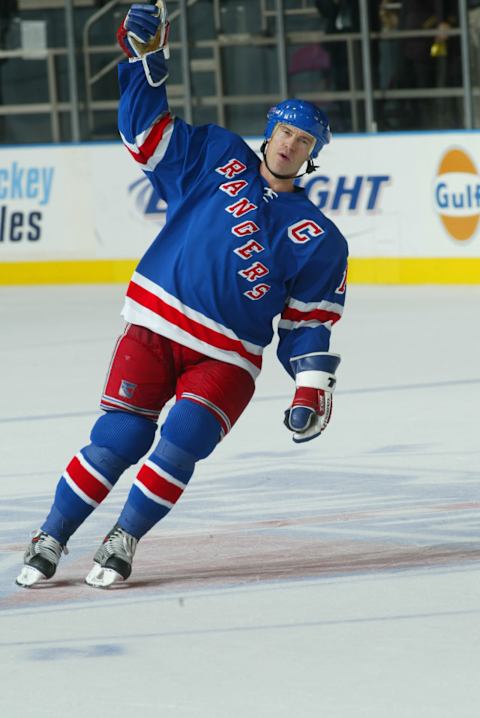
What if?
What if we got our Cup at the cost of a dynasty?
What if the Rangers remained a powerhouse in the years to come, pushing them deeper into the playoffs the next three years? What if keeping those younger players means we didn’t have to go seven years without making the postseason?
What if Keenan’s bush-league departure (because of a rift with Neil Smith), didn’t poison Messier against the G.M.? Then the Captain doesn’t self-exile to Vancouver and when Gretzky comes to town, there’s enough of a team around him for a cherry to put atop the sundae of his career. Leetch gets to retire in New York, a multiple-Cup winner. And Nick Kypreos develops into a scoring threat and perennial all-star who… Nah, I can’t sell that one, even as a joke.
Mike Keenan never duplicated his success in New York anywhere else in the NHL, though he did win a Gagarin Cup with Metallurg Magnitogorsk of the KHL in 2014. So he’s got that going for him.
Which is nice.
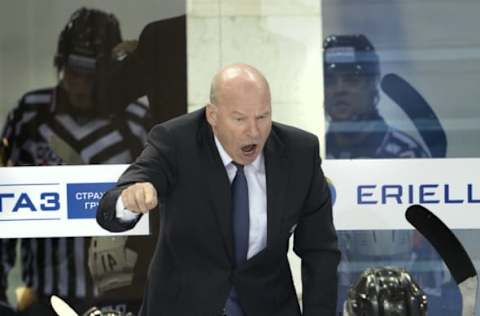
But then the Rangers haven’t won without him, either. I guess they were a match made in hockey heaven. Or hell.
We can dream of the dynasty that might have been, but to paraphrase the old saying: “A Cup in hand is worth two (or three or four) on the ice.”
Do they risk losing Morgan Barron?. light. Must Read